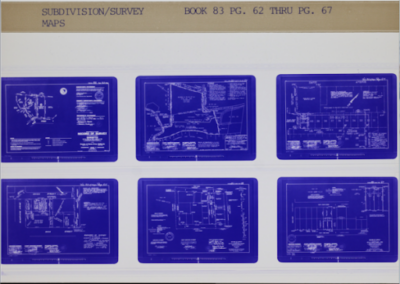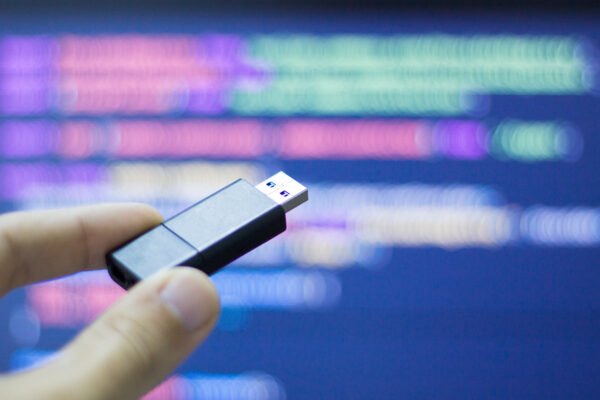Starting a large-scale microfiche scanning project can feel overwhelming, but understanding the unique challenges and considerations can set you on the path to success. This article dives deep into what makes these projects different, focusing on key factors like pricing, scheduling, logistics, and scope.
Whether you’re new to the world of microfiche or a seasoned veteran, we provide practical insights and strategies to help you through the process. If you’re ready to transform those stacks of microfiche into accessible digital resources, let’s get started.
What Is Microfiche?
Microfiche are small sheets, roughly 4×6 inches in most cases, with reduced-size photographic images of original records. In other words, they’re very small images of things that were photographed.
These records were put on microfiche so they can be stored long-term. This way, you wouldn’t need to keep the originals and save a lot of space; instead, you have these small microfiche sheets that can hold a lot of data and have the longevity to be around for a long time.

There are numerous types of microfiche, the most common being the 16mm and 35mm jacket fiche (also known as source fiche) which were originally created from microfilm. The 35mm might contain images from engineering drawings, plant sets, and things of that sort, whereas 16mm images can be anything like student records, medical records, or board minutes, typically office-sized documents. The 35mm jackets generally hold up to six images, while the 16mm jackets can hold up to 60 images.
The other common type of microfiche is COM microfiche, which stands for Computer Output Microfilm. This type of microfiche was actually created from already electronic or typed records that were then put onto microfiche for storage. These are often very good-quality images, especially with OCR text search technology. When you scan them into a digital format, they’re very useful for text searches. Compared to jacket-style microfiche, COM holds roughly 270 images per sheet, so it’s a lot of data.
Defining A “Large” Microfiche Scanning Project
When we consider a large microfiche scanning project, it typically involves tens of thousands of sheets. A couple of hundred or even a few thousand microfiche sheets constitute a small project. If you have between 5,000 to 15,000 sheets, that would be considered a medium-sized project. Once you reach the 20,000+ range, it starts becoming a large project. Of course, if you have 250,000 sheets, that qualifies as an extra-large project. The impression we want to convey is that a couple of hundred to a couple thousand sheets is on the smaller side. As you get into the tens or hundreds of thousands of microfiche sheets, it becomes a large-scale project where we can truly leverage our scale and expertise.
Project Considerations
Every microfiche scanning project is unique. You can even have the same quantity of microfiche, let’s say 10,000 microfiche of 16mm jackets from a police department. So, same department, same records, with criminal records, same material, 16mm jacket fiche, but there are still going to be differences for each project.
We approach each project with a customized process, ensuring that your project will have a custom process flow designed specifically for your needs. This ensures that every requirement for your project is addressed and taken care of. Below are some of the considerations for your individual project.
Price
The price for your specific project will be heavily dependent on the quantity of microfiche sheets. The quantity of sheets is one of the biggest factors in determining the scope and pricing of your project because it’s one of the simplest ways to assess whether it will be very small, like a short project, or if it will require lots of time and resources. Let’s say you have 300,000 sheets; that will be a major factor in the price.

Additionally, the type of microfiche is essential to your price. As we mentioned above, there are several different types, and those we mentioned are not the only types. There are many more that can affect the price because some require special scanning processes, take longer, or require more post-scan image processing. Each type of fiche is a little bit different, so the type of fiche is also a major factor in the price of your project.
Schedule
The timeline that you need for your project to be started and completed is an essential factor. Depending on when you need it to start or finish, we may need to adjust some projects internally and redirect some resources to ensure that your project is completed. Especially with a large project, let’s say you have hundreds of thousands of sheets, it takes considerable resources from our employees as well as time and production capacity. Therefore, your timeline and what we need to do will be important.

For example, if you have 150,000 sheets of 16mm jacket fiche, we might estimate that it will typically take about 4-6 months to complete. However, if you need it done in 3 months guaranteed, that is essential to know. This way, we can confirm that we can meet that timeline and allocate the necessary resources to ensure it’s accomplished, while also adjusting other projects as needed.
Logistics
Logistics are very important to consider with your project because the scanning and actual digitizing of your microfiche is the core of what you’re trying to accomplish. However, you still need to get the fiche to us so we can perform the scanning.
There are a couple of different ways to handle this. If you’re local to our facilities or in the regional area, we can pick them up and drive them back to our facility. Alternatively, maybe someone from your team can deliver the records to us.
If you’re not close enough for a simple pickup, we can send one of our employees to fly out to your location, rent a vehicle, and then drive the material back. That’s something we’ve done before.

The most common method is straightforward shipping. You can box up the microfiche and send it to us. If you want added security for your records, we can send you our lockable Pelican cases, where you pack up your fiche and then send them back to us. For large microfiche scanning projects, it might be necessary to handle it in batches. This involves sending us a batch of fiche for scanning, we will send the cases back, and then you fill them with new fiche and return them to us. This can be done on a rotating basis.
Regardless of the type of shipping we decide to work on together, it’s important that we create a solid plan to ensure the fiche are ready for implementation before we execute the contract and get started. While we’re working on the project scope and contracting, having a comprehensive logistics plan will play a key role. We’ll collaborate with you to ensure smooth project procedures, including getting the fiche to us.
Scope
The project scope determines how the microfiche will be scanned and what will happen to it once it’s digitized. Below are some key aspects of the project scope you should understand:
- Quantity of sheets
As we mentioned above, the quantity of your microfiche will be a large determinant of the scope of your project, not only for the price but also for the timeline and logistics. Essentially, this is a significant part of how we formulate the scope and plan for your project.
- Indexing
Other than quantity, indexing the fiche (or digitally naming the electronic records once they’re scanned) is one of the most critical aspects of the project. Sure, getting them scanned is important, but you want to be able to use and access these files once they’re digitized. You need to make sure you name them in a way that makes them easily accessible so you can actually get to them. You don’t want to make it too complicated where you’re not able to find anything.We recommend a building block approach when it comes to indexing, which involves replicating the way you currently find your microfiche. You can make it more complex later if needed. For example, you may locate data by flipping through the fiche using the title strips. The simplest way to replicate that is by capturing the information from those titles. Going beyond that, such as parsing the data out or attempting image-level indexing, can be useful but likely more expensive, and it might not make much of a difference compared to title indexing.You’re already digitizing the records, which will make them more efficient. Therefore, we recommend starting small by replicating your current method. Later, if you think you could benefit from improved indexing, such as image-level or file-level indexing, you can implement it then. However, you don’t need to spend the money upfront.
- Delivery method
The delivery method is basically how you want to receive the final product, and there are a couple of parts to that.- File format
The file format can be traditional, such as PDFs, JPEGs, TIFFs, etc., or can be accessed via our secure hosted application, Digital ReeL. In general, if we know the file format ahead of the project, this part of the process is pretty straightforward. Issues sometimes arise if you decide to change the file format after we’ve already created the process flow and started the project. This can result in minor hiccups, but usually, it’s not a major concern. - File delivery
Once the project is complete—the fiches have been scanned, indexed, and processed—it’s time to actually get you the images and data.Standard methods include USB hard drives or thumb drives, or you could use SFTP, which is a method for electronic delivery. Alternatively, you might utilize our hosted Digital ReeL application. There are many options for the data transfer, but knowing how you want to receive the records once we complete the project is a key part of the scope to ensure it is wrapped up properly. - Do you have the resources to ingest the data?
Something to consider when you are receiving these images and files, especially on large projects where there are going to be hundreds of thousands or even millions of images, is whether you have the resources to ingest that data.
People often underestimate how much data is created from microfiche, especially with large projects of hundreds of thousands of fiche sheets. They may not have sufficient resources on their end to store it. The exact data size remains uncertain until the project is completed, as that’s the nature of digitization. However, there are ways to estimate how much data you will receive, so you can be prepared when you get the files.
- File format

How To Get Started
Now that you know a bit about large microfiche scanning projects, you’re probably wondering, “How do I actually get started?” That’s a great question.
First, like you’re doing now, do your research. Read websites, blogs, watch videos, or attend webinars—anything that relates to microfiche scanning should be on your radar so you gain some general knowledge of how these projects work and what to look for. We’re not saying you need to spend tens of hours doing this because you’re not trying to be the expert, but you should spend a little bit of time learning about these processes and what goes into a microfiche scanning project before you reach out to companies for their assistance.

Once you do start talking to companies, ask if you can do a sample. When you have tens of thousands or even hundreds of thousands of microfiche sheets, it’s very likely that the company you’re talking to will want to do a sample anyway, but you should ask and say, “Hey, if everything seems right, could we do a sample so we can see how this works?”
Now, with these samples, you’re not just looking for the resulting images and scans—that’s, of course, a big part of it—but you’re also looking to see how you work with that company. If they’re communicative, helpful, and guide you smoothly through the process, and everything gives you that comfortable feeling about them, that’s a huge piece of the puzzle aside from the actual quality of the images and scans. However, if you don’t get a good feeling, if communications are bad, if it takes too long, or whatever it is doesn’t go right, that’s probably an indication of how the big project will go. So, samples are a great way to get some insight into a company.
A pilot project is deeper than just a sample. If you have 100,000 feet of microfiche and do a sample of five sheets or so to get a general idea, that’s one thing. However, a pilot project goes a bit further. Some companies offer pilot projects where a milestone process flow is created. This could involve a $5,000 to $10,000 project to conduct a Milestone One proof of concept, running a couple of thousand fiche through that, offering a better idea of the full project scope without proceeding with the entire project. If the pilot project goes well, you can see how the service operates with larger quantities and then confidently move forward with the rest of the project.
Once you decide to start the project, if you have a large volume of fiche, you need to determine how to proceed. Perhaps you’re digitizing for storage, sending the entire batch or collection at the same time, which is one approach. But if you’re accessing these records frequently, prioritize the more active fiche first, so you can start using digital versions and stop relying on hard copies. Or, you might send the least active first, holding onto frequently requested ones until the end. Consider these options carefully.
Finally, if you send microfiche in batches and receive requests for them, how will you manage without having the fiche records at hand? Our solution is the BMI Request System (BRS), designed for this scenario. If the fiche records are with us and you receive a request, simply log into the BRS application and submit it. We prioritize your microfiche record, scanning it into digital images and data for your needs. The BRS system assists many clients by managing their records effectively while the fiche is out of their hands.
In Closing
Embarking on a large-scale microfiche scanning project may seem daunting at first, but with careful consideration of key factors like cost, timing, logistics, and scope, you can pave the way to a successful transition from physical to digital. Remember, thorough planning and understanding the unique aspects of your project will not only ensure efficiency but also unlock potential cost savings and other benefits. Take the first step with confidence, knowing that a well-executed scanning project can transform your data management and accessibility for years to come.
Next Steps
Reach out to us today! Click the “Get Your Quote” button below, fill out the form, and we’ll quickly reply to you to discuss your project.
Further Reading
The BMI Microfiche Scanning Process
Do you have microfiche records you want to scan and are curious about how it’s done? Our 11-step microfiche scanning process will show you how we convert your physical microfiche collection to digital files, covering tracking, preparation, scanning, digital delivery, and more.
Types Of Microfiche
Learn about the various types of microfiche including the common 16mm and 35mm jacket fiche, the image-heavy COM fiche, and more.
Dos & Don’ts For Successful Digital Conversion
Digital conversion projects can be simple, but that doesn’t mean they’re easy. In this article we’ll give you some “dos” that’ll get your project moving in the right direction (success!) as well as some “don’ts” that you’ll want to avoid.

